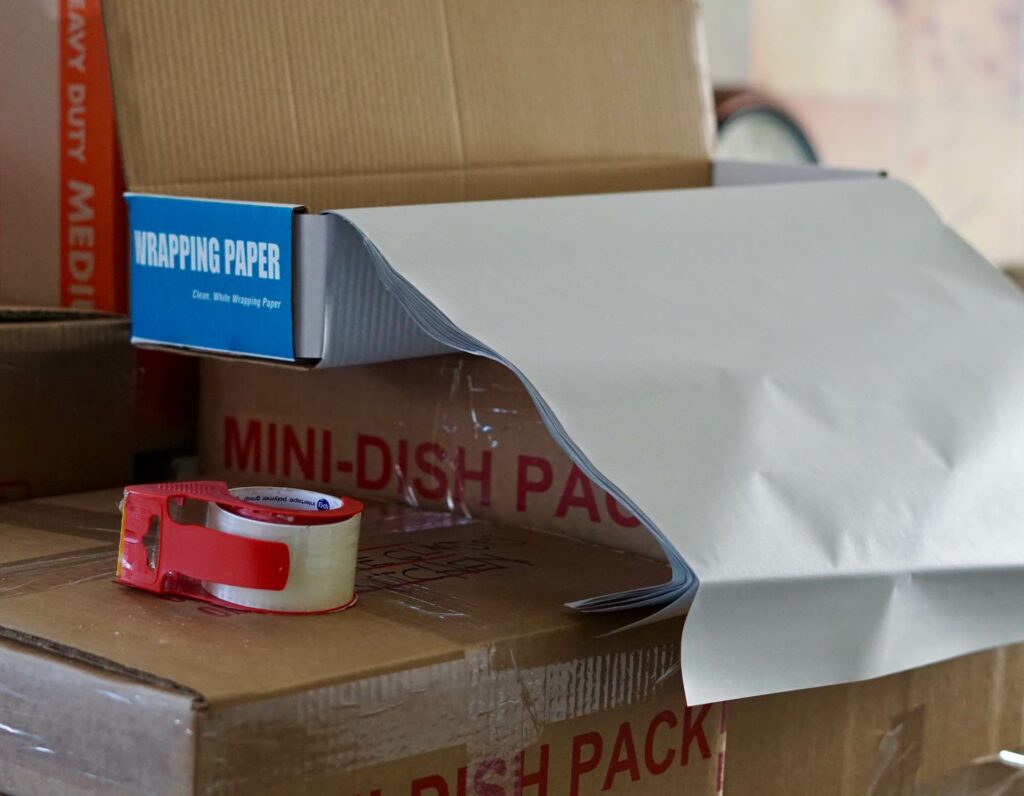The only packing supplies checklist you’ll need for a great move.
Moving to a new home can be an exciting adventure, but the process of packing up your belongings can often be overwhelming. Having the right packing supplies on hand can make a significant difference in ensuring a smooth and organized move. To help you stay on top of your packing game, we’ve put together the ultimate packing supplies checklist. Let’s dive in!

Essential Packing Supplies Checklist
1. Cardboard Moving Boxes
Cardboard moving boxes are one of the most essential packing supplies when it comes to moving. Different sizes are available depending on your needs – small boxes for books and heavier items, medium-sized boxes for clothing and linens, and large boxes for bulky items like pillows or blankets. Specialty boxes can also be purchased which are designed to protect fragile items during transit. It’s important to have enough cardboard moving boxes on hand so that you don’t run out mid-move; if possible, aim to purchase at least 10-15 more than you think you’ll need in case of any unexpected packing surprises.
2. Packing Tape
Moving and packing tape is an essential item for any move. It can be used to secure boxes, furniture, and other items that need to be moved. It is also a great way to label boxes so that they can easily be identified once they arrive at their destination. When selecting packing tape, choose one that is strong and durable enough to securely hold the contents of the box in place during transit
3. Bubble Wrap
Bubble wrap is a popular packing material for moving, as it protects fragile items from bumps and breaks during transit. It’s important to use bubble wrap properly when packing for a move.
Use the right size bubble wrap—small bubbles for fragile items like glassware, and large bubbles for heavier items like furniture.
4. Packing Paper
When packing delicate items, packing paper is essential for protecting the item from scratches and breakage. Packing paper is a type of wrapping material that is made up of thin sheets of plain white paper. It can also be used to cushion items while providing an extra layer of protection when packed into boxes or other containers.
5. Packing Peanuts or Foam Sheets
Using packing peanuts or foam sheets to provide extra cushioning for fragile items within boxes is an effective way to prevent breakage while shipping. These materials are lightweight and can be easily placed around the item inside the box to keep it secure and safe from damage. Packing peanuts are best used for large objects as they have a greater capacity of filling in spaces between the item and the walls of the box
6. Marker Pens
It is important to use permanent markers to label boxes with the contents and the room they belong to during a move. This will make it easier for unpacking each box once you arrive at your new home. Here is a checklist of items you should have on hand when labeling boxes:
7. Scissors or Box Cutters
When moving, there are a few supplies you should have on hand to ensure the process goes smoothly. A pair of scissors or a box cutter can come in handy when wrapping items in bubble wrap and tape, cutting through plastic packaging, and opening sealed boxes.
8. Ziplock Bags
Using ziplock bags for storing small parts, screws, and other loose items during a move is an excellent way to keep them organized and easy to find. Before packing up these items, it’s important to make sure you have enough ziplock bags on hand. Here’s what you should include in your packing supplies checklist:
9. Furniture Covers
Furniture covers and furniture pads provide protection for furniture when moving. They are essential items for anyone who is packing up their home, as they will help keep furniture safe during the journey to its new home.
Furniture covers provide a layer of protection from dust, dirt, and scratches that could occur during the move. Furniture pads offer additional cushioning to avoid dents and
10. Stretch Wrap
Stretch wrap is a thin plastic material that can be wrapped around items to keep them secure during a move. It is also helpful for keeping drawers and doors closed during transport, as it provides a strong hold. Stretch wrap comes in various lengths, so make sure you have enough on hand for your move.
PRO TIP: Read Benefits of Hiring Professional Packers and Movers

Specialty Packing Supplies Checklist
1. Wardrobe Boxes
When it comes to packing your clothes for a move, using tall boxes with a hanging bar is an essential part of the process. Tall boxes are ideal for storing items such as dresses, suits, and other clothing that might need to hang during the move in order to avoid wrinkles. These boxes have a bar along the top which can be used to hang your clothes from hangers, allowing you to
2. Mattress Bags
Mattress bags are essential packing supplies for anyone moving to a new home or apartment. These bags are designed to fit snugly around the mattress, providing an extra layer of protection to keep it clean and undamaged during the move. Mattress bags come in various sizes and styles, allowing you to find one that fits your mattress perfectly. When preparing for the move, make sure that you have
3. Dish Boxes and Dividers
Dish boxes and dividers are essential packing supplies for keeping dishes and glassware safe during transit. When packing dishes and glassware, make sure to use the right sized dish box and dividers that are specifically designed to fit the items you’re packing. Be sure to carefully secure all of the edges of the box with tape or other packing materials. Once you have selected your dish boxes
4. Mirror and Picture Boxes
When packing up mirrors, artwork, or other delicate flat items, it’s important to use the right kind of boxes and supplies to ensure they arrive in one piece. Mirror and picture boxes are specially designed for this purpose. These boxes have extra thick walls and a superior cushioning system to protect your fragile items during transit. They also come with custom-shaped inserts that will be tailored to fit your
5. Electronics Boxes
When it comes to securely packing your electronics for moving, specialized boxes and padding are essential. Using the wrong materials or failing to properly secure delicate items can lead to costly damage, so it’s important to make sure you have all the right supplies on hand before getting started. Here is a checklist of items that will help ensure your electronics arrive safely:
6. Moving Blankets and Moving Pads
Moving blankets are an essential item to include in any packing supplies checklist for a move. These blankets provide extra cushioning and protection for furniture, appliances, and other larger items during the move. Not only do they provide cushioning to protect your belongings from dents, scratches, or other damage, but they also help keep them clean and free of dust.
Pro Tip: Learn Where to Find Free or Inexpensive Packing Boxes
Miscellaneous Packing Supplies Checklist
1. Tools Disassembly and Assembly
When you’re packing up your home to move, it pays to keep a basic toolkit handy for disassembling and reassembling furniture. While you can often get away with packing large items like sofas and beds without taking them apart, smaller pieces like tables, chairs, and desks require some disassembly. Having the right tools on hand will make the move much smoother.
2. Trash Bags
When it comes to packing for a move, one often overlooked item are large trash bags. These can be incredibly helpful when trying to get rid of items that you don’t want to bring with you. Whether you are looking to donate items, recycle them, or just throw them away, having large trash bags on hand can make the sorting process much easier. When packing up your belongings,
3. Dolly or Hand Truck
Using a dolly or hand truck when moving heavy boxes and furniture can be a real lifesaver for your back. Not only do they make it easier to move these heavier items, but it also protects them from damage that may occur during the move.
4. Rope, Bungee Cords, Moving Bands
When packing for a move, it is important to ensure that your items are properly secured in the truck. This will help to prevent them from shifting around during transit and potentially causing damage. To achieve this, you should use strong rope, straps, bungee cords, or moving bands.
5. Gloves
Wearing work gloves to protect your hands while packing and moving is critical. Moving heavy items such as furniture, appliances, packing supplies, boxes and other belongings can put a strain on your hands. Work gloves are designed to protect your hands by providing cushioning, grip, and preventing abrasions or cuts that could occur when handling heavier items. It is important to make sure the gloves fit
6. First Aid Kit
When you are packing for a move, make sure to include a basic first aid kit in your supplies. Accidents can happen when moving furniture and boxes, so it is important to have the necessary items on hand in case of injury. A basic first aid kit should include adhesive bandages for minor cuts and scrapes, antiseptic wipes for cleaning wounds, gauze pads and adhesive tape to
Tips for Organizing Your Move:
1. Use Color-Coded Labels or Stickers for Rooms and Boxes
When it comes to moving, one of the best ways to ensure a smooth transition is by labeling and organizing your boxes according to room. Assigning each room a color can be an effective way to keep track of where everything should go.
2. Create A Moving Planner or Notebook
Having a moving planner and notebook to organize your move is critical. Grab a 1 inch 3-ring binder and label it as your move notebook or move planner. Have one person in your family as the lead planner responsible for keeping track of your move planner. This notebook or move planner should include a variety of important documents related to your move. Here are some of the items to include in this move planner or notebook:
- Comprehensive packing supplies checklist should be included in the planner to ensure that you have everything you need for a successful move.
- Room by room packing inventory that includes a list of all items that were packed in a room and how many boxes were packed for each room.
- Important documents for your move such as lease agreements, mortgage documents, insurance documents, your moving company contract, vehicle insurance, etc.
- Important contact information with names and phone numbers such as your movers phone number, the moving crew lead, homeowners or renters insurance company, mortgage company or landlord, etc.
3. Ziplock Bags or Pouches
Using ziplock bags is an efficient way to store small items like screws, bolts, and cords. This keeps them in one place and makes them easier to find. It’s also a great way to stay organized and save time when you need to access the items. To ensure that everything stays organized it’s important to label the ziplock bags clearly with what they contain.
6 Tips to Help You Plan and Pack Efficiently
1. Start Planning and Packing Early
Start planning and packing for your move early. Moving can be a stressful, particularly when you are trying to manage the entire relocation process on your own. To make this experience easier, it is best to start planning and packing early. Begin by creating an inventory of all the items that you will need to pack and move. Then, begin packing non-essential items first followed by other items as you get closer to your move date.
Pro Tip: Download Our 10 Week Moving Preparation Guide and Checklist
2. Declutter Your Spaces and Purge Your Belongings
When preparing to move, it can seem daunting to sort through all of your belongings and decide what should stay and which items should be donated, sold, or discarded. However, taking the time to properly purge and sort through your stuff before you start packing can save valuable time and energy during the move process.
Pro Tip: Learn Our 15 Ways to Declutter Before Your Move
3. Plan to Pack Room by Room
Moving can be a stressful time, but it doesn’t have to be. One way to make the whole process much easier is to pack up your home one room at a time. This will help you keep track of what needs to be done in each area and make sure that nothing gets left behind.
4. Always Pack Heavy Items at the Bottom of Your Boxes
When packing boxes for a move, it is important to take special care when arranging and organizing the items in each box. Be sure to place heavier items at the bottom of boxes and lighter items on top to prevent or minimize damage to your belongings.
Pro Tip: How to Prevent Damage to Fragile Items During Your Move
5. Take the Time to Clearly Label Your Boxes
When moving, it is important to clearly label your packing boxes. Properly labeling your packing boxes will save you time and energy in the long run when it’s time to unpack them. Labeling each box with a brief description of its contents and the room they belong to will help you quickly identify what is in each box so that you can easily find items that you need during the move and after.
6. Be Sure to Pack Essentials For A Few Nights Separately
Pack a separate bag with essentials like clothes, toiletries, and important documents for the first few days in your new home.
When you’re packing for a move, it’s important to pack a separate bag with essential items that you will need for the first few days in your new home. This bag should contain clothes, toiletries, and important documents that you may need during this transition period. And, be sure that your move planner or move notebook with important documents is keep with these items so you can have them with you while traveling.
Summary of Other Helpful Moving and Packing Resources:
Benefits of Hiring Professional Packers and Movers
Where to Find Free or Inexpensive Packing Boxes
How to Prevent Damage to Fragile Items During Your Move
15 Ways to Declutter Before Your Move
10 Week Moving Preparation Guide and Checklist
Conclusion:
Moving can be a daunting task, but with the right packing supplies and a well-organized approach, you can make the process smoother and less stressful. Happy moving!



